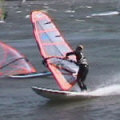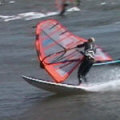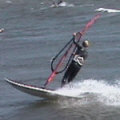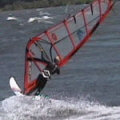Duck Jibe
The ubiquitous Duck-Gybe is easier than a gybe as evident by all the sailors on the water supporting grey beards and pink helmets who toss those Duck-Gybes like farmers bailing hay. Don't get me wrong -- I love these guys! I think they should form a national association of some sort. Named the Duck-Gybe because you duck the sail ...kind of...and not because you are suppose to quack like duck while making this move. To say the least, a fluid and effortless carving duck gybe is by anyone's measure-- a beautiful sight.







Rider: Royn Bartholdi
Steps
 1)
Get in the free position, reach your back hand further back on the boom, and head down wind while sheeting in the sail. You can slightly lay down the sail for an easier duck.
1)
Get in the free position, reach your back hand further back on the boom, and head down wind while sheeting in the sail. You can slightly lay down the sail for an easier duck.  2)
Let the board settle into a nice deep carve, just past a broad reach or a little further. Initiate the maneuver by releasing the front hand and pull the clew hand up toward your head.
2)
Let the board settle into a nice deep carve, just past a broad reach or a little further. Initiate the maneuver by releasing the front hand and pull the clew hand up toward your head.  3)
Reach the open hand to the clew end of the boom by crossing your arms while keeping your knees bent and carving the board.
3)
Reach the open hand to the clew end of the boom by crossing your arms while keeping your knees bent and carving the board.  4)
Now yank your new clew hand across your body and out away past your leeward ear. Yank quickly and aggressively because the pull is important so the boom will rotate to a position for you to reach the other side properly.
4)
Now yank your new clew hand across your body and out away past your leeward ear. Yank quickly and aggressively because the pull is important so the boom will rotate to a position for you to reach the other side properly.  5)
Reach the new forward hand to the front part of the boom. The mast edge of the sail may want to fall toward the water. No problem -- as long as it does not touch the water. If it does, you are going for a nasty crash over the nose of the board.
5)
Reach the new forward hand to the front part of the boom. The mast edge of the sail may want to fall toward the water. No problem -- as long as it does not touch the water. If it does, you are going for a nasty crash over the nose of the board.  6)
Grab the boom on the windward side of the sail. Remember to keep carving the board by bending your knees and leaning forward. If you have tons of speed then you can really slash out of this turn otherwise perform a wider arc with less rail pressure to keep the board planning out of the maneuver.
6)
Grab the boom on the windward side of the sail. Remember to keep carving the board by bending your knees and leaning forward. If you have tons of speed then you can really slash out of this turn otherwise perform a wider arc with less rail pressure to keep the board planning out of the maneuver.  7)
Switch the feet, trim, adjust, and sail away.
7)
Switch the feet, trim, adjust, and sail away. Tips
- The more speed into the move the better.
- Keep your weight forward and knees bent.
- Visualize pulling the clew past your ear and out toward the sky.
- If mast of the sail is dropping to the water then you are ducking too early.
- If the sail gets away from you (downwind) then (1) your ducking to early, or (2) You do not have enough speed or, (3) your not yanking the sail hard enough.
Ideas
- I have seen Double-Duck-Gybes. Try a triple.
- No feet change. Sail out in switch stance.
- Duck then jump around to leeward sailing.
- How about a duck followed by some sort of switch stance maneuver.
- Duck the sail then go into a Carving-360.
All Contents Copyright © 2008-2025 Royn Bartholdi. All Rights Reserved